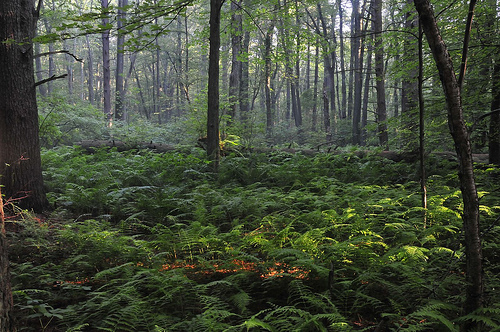 |
| Some forests today bear similarities to their Jurassic forebears |
Leaves and shoots are notoriously poor nutrition, which is why cows spend most of their day eating. They have no less than four bacteria-filled stomachs to break down grass and will regurgitate the partially digested pulp in 'chewing the cud.' The sauropods, weighing tens of tonnes, would have needed an even greater proportion of food daily.
The forests of the Jurassic Earth were extensive. Yet how could so many different species of herbivorous dinosaurs, living in large herds, coexist, particularly with such phenomenal dietary requirements? Competition would have been rife. This issue confounded the reconstruction of Mesozoic ecosystems until recently through a joint piece of research by the University of Bristol and the Natural History Museum, London. By calculating biomechanical constraints on the skulls of different sauropod species, it was found that different species selected different plants as food.
 |
| The CT scan of Camarasaurus |
'Our results show that although neither could chew, the skulls of both dinosaurs were sophisticated cropping tools,' said David Button from Bristol's School of Earth Science. 'Camarasaurus had a robust skull and strong bite, which would have allowed it to feed on tough leaves and branches. Meanwhile, the weaker bite and more delicate skull of Diplodocus would have restricted it to softer foods like ferns. However, Diplodocus could also have used its strong neck muscles to help it detach plant material through movements of the head. This indicates differences in diet between the two dinosaurs, which would have allowed them to coexist.'
'In modern animal communities differences in diet such as this - termed 'dietary niche partitioning' - allow multiple similar species to coexist by reducing competition for food,' added Professor Emily Rayfield also from The University of Bristol. 'Although, dietary niche partitioning has been suspected between Morrison Formation sauropods based on their structural features and patterns of tooth-wear, this is the first study to provide strong, numerical, biomechanical evidence for its presence in this fossil community.'
The struggle for food drives many interactions in ecosystems across the globe. In modern examples we can study and test to see which factors determine how species can coexist in the same habitat. Ancient ecosystems are more of a challenge, yet slowly we are piecing together the fragments of these lost, fascinating worlds.